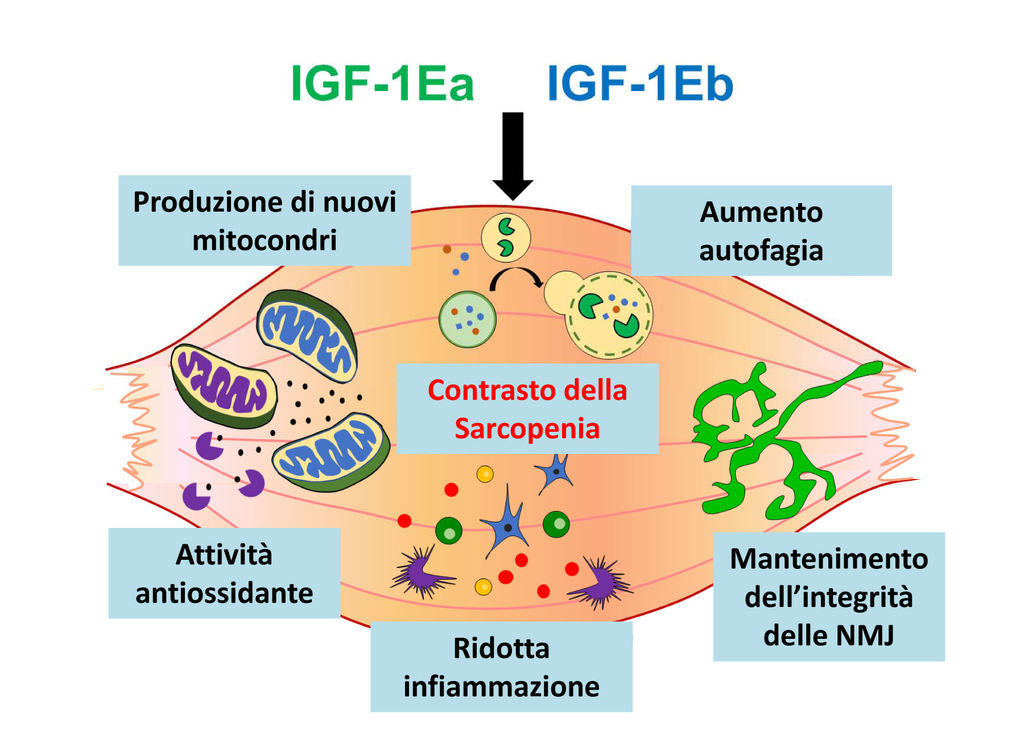
Rejuvenating Muscles: Sapienza Researchers Characterized the Molecular Mechanisms to Block Muscle Ageing
One of the first effects of ageing is the loss of skeletal muscle mass associated with a reduction in strength. This process, known as sarcopenia, is often accompanied by an alteration of neuromuscular junctions, causing an impairment of communication between the nervous system and muscle tissue. Thus, it is critical to keep muscles healthy and functioning even in old age to increase the quality of life of elderly.
In order to shed light on this mechanism, a new study, coordinated by Antonio Musarò’s Research Group at the Sapienza Department of Anatomy, Histology, Forensic Medicine and Orthopeadics, in collaboration with the Italian Pasteur Institute, Catholic University of Rome and Jackson Laboratory (USA), has analysed the IGF-1 Growth Factor that plays a crucial role in muscle differentiation.
In particular, the study focused on the molecular mechanisms through which two different forms of IGF-1 (IGF-1Ea and IGF-1Eb), which are encoded by the same gene but with different effects on muscle growth, can reduce muscle deterioration related to age. The results of the study have been published on Aging Cell.
The researchers generated two different animal models in which the encoding gene for either IGF-1Ea or IGF-1Eb was selectively expressed in the voluntary muscles of normal mice. This generated two genetically modified mice (one overexpressing the IGF-1Ea isoform and the other the IGF-1Eb isoform) that were then compared each other and with normal mice.
“The first interesting result,” explains Antonio Musarò, “was that only isoform IGF-1Ea was capable of significantly increasing muscle mass, inducing pronounced muscle hypotrophy that was associated with an increase in strength, a feature maintained during the entire post-natal life of transgenic animals. Moreover, our data,” adds Musarò, “evealed that both IGF-1 isoforms counteracts sarcopenia, the decline of muscular mass and strength in old age, increasing the performance of older mice.”
The maintenance of a youth muscle phenotype is guarantee by the induction of signaling pathways, normally altered during aging, such as autophagia, which is a fundamental survival physiological process that cells use to degrade damaged organelles and cellular components.
The activation of these molecular mechanisms is essential for the production of functional new mitochondria and for the maintenance of healthy neuromuscular junctions, guaranteeing muscle activity and muscle-nerve interaction.
The study, which was supported by the Italian Pasteur Institute, Fondazione Roma, Italian Space Agency (ASI) and Faculty projects, opens up new perspectives for the development of specific therapeutic approaches to counteract muscle weakness in old people, whilst also satisfying the requisites for “excellent science” and “better society” called for by European Programme Horizon 2020.
References:
Effects of IGF‐1 isoforms on muscle growth and sarcopenia - Ascenzi F, Barberi L, Dobrowolny G, Villa Nova Bacurau A, Nicoletti C, Rizzuto E, Rosenthal N, Scicchitano BM, Musarò A. - Aging Cell 2019; e12954.
DOI: https://doi.org/10.1111/acel.12954
Further information
Antonio Musarò
Department of Anatomical, Histological, Medical Legal and Locomotor Sciences, Sapienza University of Rome
antonio.musaro@uniroma1.it
